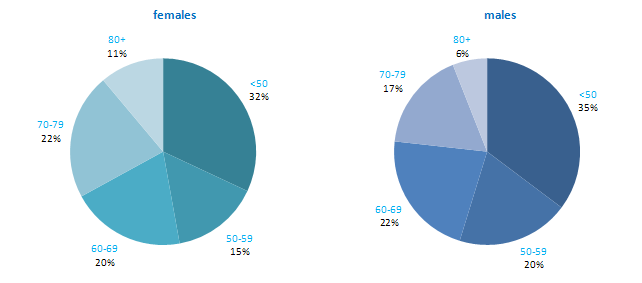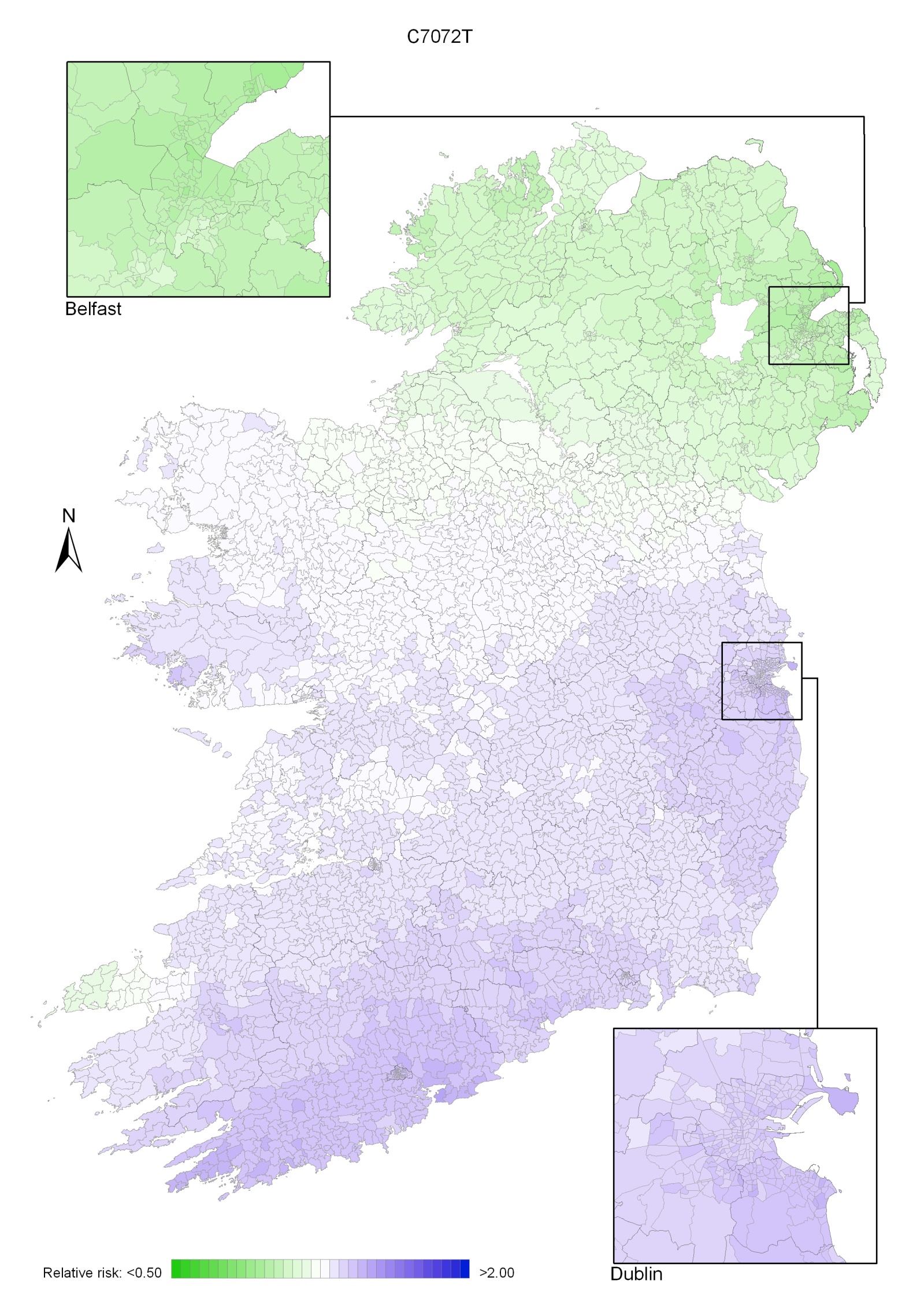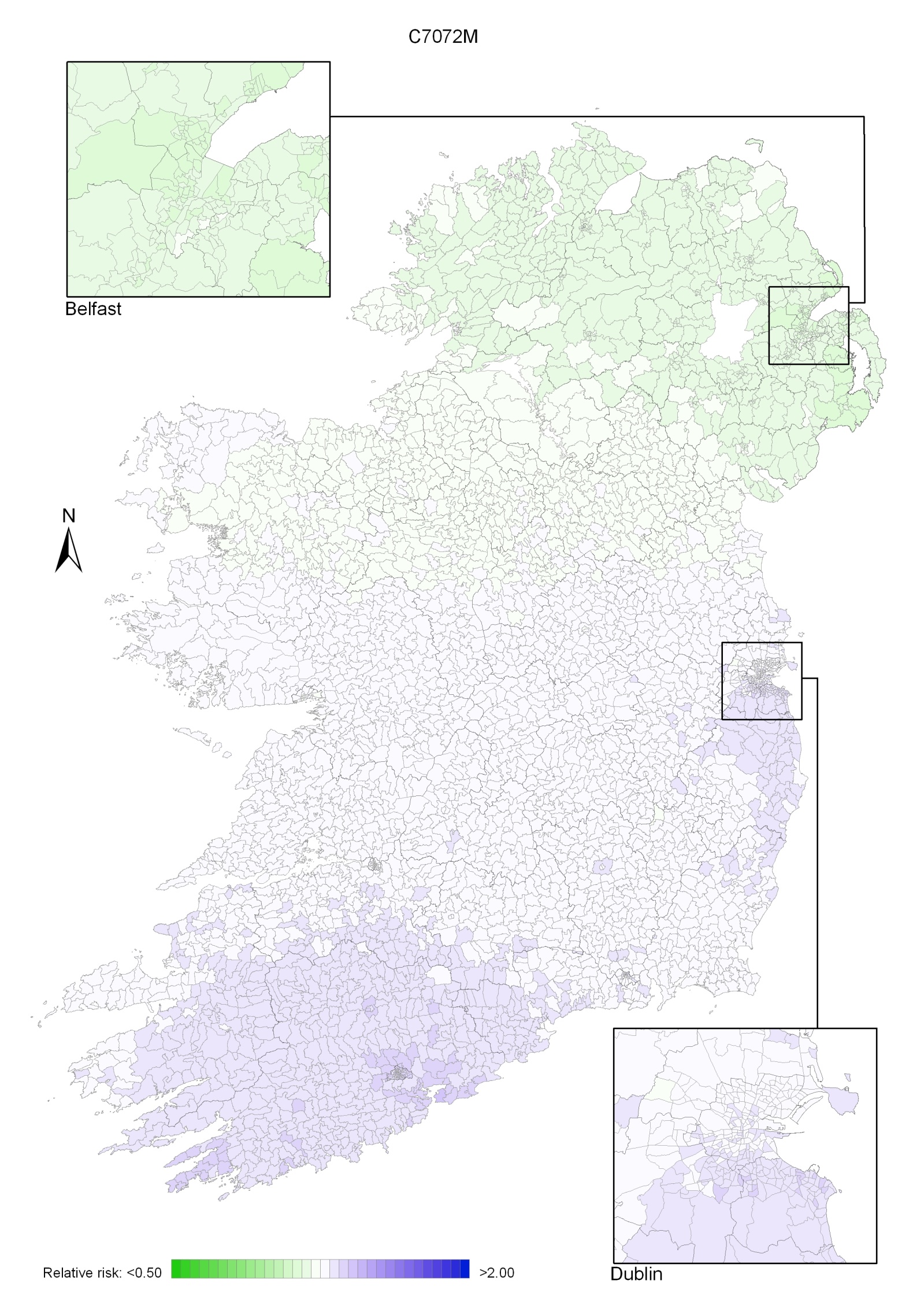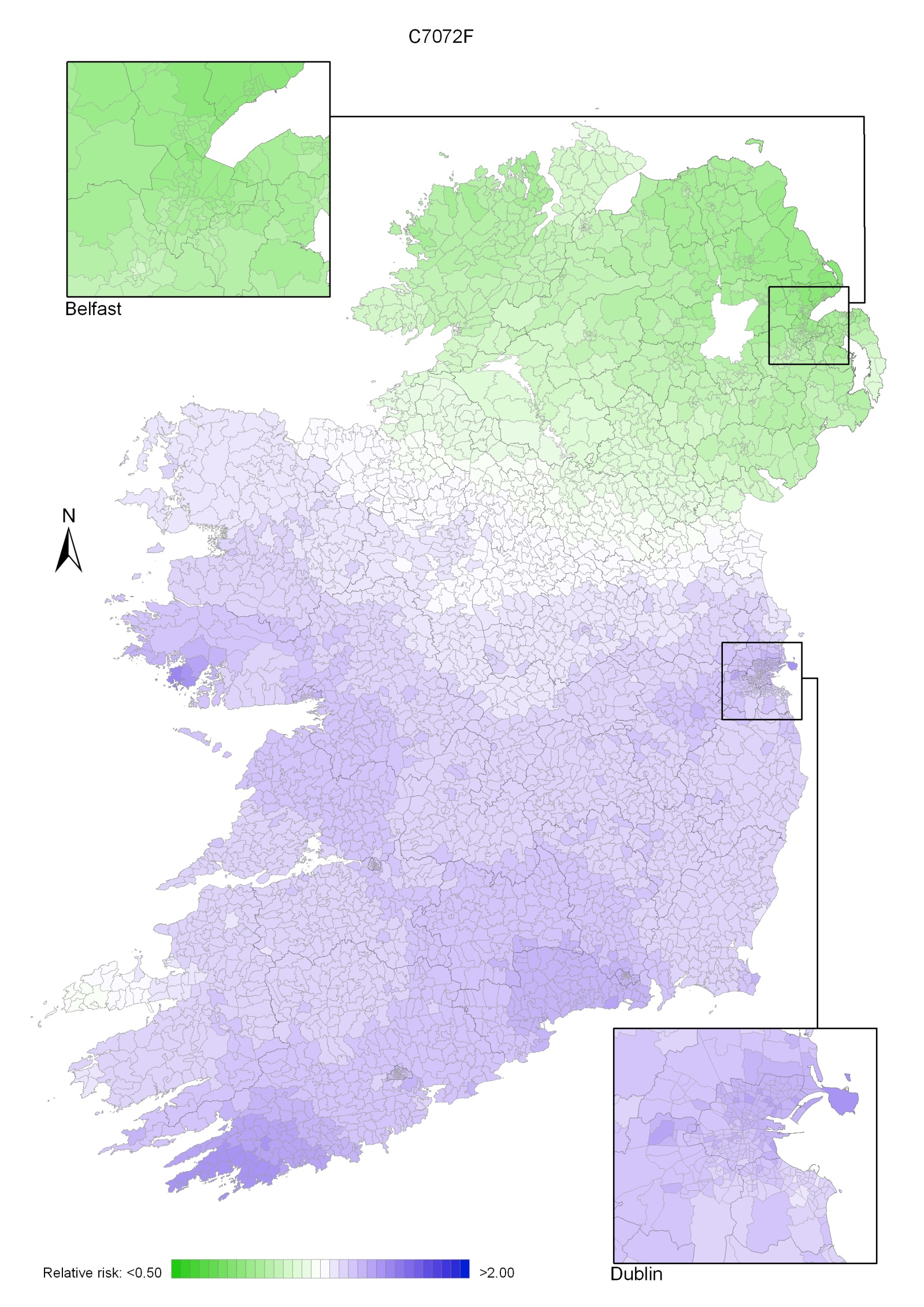

The group of cancers of the brain and other central nervous system includes those which occur in the brain (more than 90% of the cancers), meninges (~3%) and cranial nerves or spinal cord (~3%); (National Cancer Registry, 2010b). Brain and other central nervous system cancer (CNS) was the fifteenth most common cancer in Ireland, accounting for 1.7% of all malignant neoplasms, excluding non-melanoma skin cancer, in women and 2.1% in men (Table 18.1). The average number of new cases diagnosed each year was 174 in women and 234 in men. During 1995-2007, the number of new cases diagnosed showed an overall increase of approximately 3% per annum.
The risk of developing brain and CNS cancer before the age of 75 was 1 in 204 for women and 1 in 134 for men and was slightly higher in RoI than in NI. At the end of 2008, 563 women and 706 men aged under 65, and 123 women and 111 men aged 65 and over, were alive up to 15 years after their cancer diagnosis.
Table 18.1 Summary information for brain and other central nervous system cancer in Ireland, 1995-2007
Ireland | RoI | NI | ||||
females | males | females | males | females | males | |
% of all new cancer cases | 1.2% | 1.5% | 1.3% | 1.6% | 1.1% | 1.5% |
% of all new cancer cases excluding non-melanoma skin cancer | 1.7% | 2.1% | 1.8% | 2.2% | 1.4% | 2.0% |
average number of new cases per year | 174 | 234 | 125 | 166 | 49 | 68 |
cumulative risk to age 74 | 0.5% | 0.7% | 0.5% | 0.8% | 0.4% | 0.7% |
15-year prevalence (1994-2008) | 686 | 817 | 467 | 571 | 219 | 246 |
Cancer of the brain and CNS was predominantly a disease of younger persons (Figure 18.1). Approximately half of all new cases presented under 60 years of age (55% of men and 47% of women). The average age at diagnosis was younger in NI than in RoI.
Figure 18.1 Age distribution of brain and other central nervous system cancer cases in Ireland, 1995-2007, by sex

Denmark, Norway and Sweden had the highest rates of brain and CNS cancer in 2008 for both men and women, in a comparison of developed countries (Figure 18.2). Japan, Russia and Austria had the lowest rates of the disease. Both RoI and NI had slightly higher than median rates for men, as did RoI for women.
Figure 18.2 Estimated incidence rate per 100,000 in 2008 for selected developed countries compared to 2005-2007 incidence rate for RoI and NI: brain and other central nervous system cancers | |
| females | males |
 |  |
Source: GLOBOCAN 2008 (Ferlay et al., 2008) (excluding RoI and NI data, which is derived from Cancer Registry data for 2005-2007) | |
Table 18.2 Risk factors for brain and other central nervous system cancer, by direction of association and strength of evidence
Increases risk | Decreases risk | |
Convincing or probable | Ionizing radiation1,2 | Allergic conditions7 and asthma8,9,10 |
| Radio-frequency electromagnetic fields3,4 | |
Possible | Occupational exposure to formaldehyde5 | |
| Farming6 | |
| ||
1 El Ghissassi et al., 2009; 2 National Toxicology Program, 2011; 3 fields with a frequency range of 30kHz- 300GHz; typically emitted by mobile phones, cordless phones, amateur radios, high-frequency dielectric or induction heaters, mobile phone stations, broadcast antennas and medical applications; 4 Baan et al., 2011; 5 National Toxicology Program, 2010; 6 Khuder et al., 1998; 7 including eczema, hay fever and rhinitis; 8 Chen et al., 2011; 9 McCarthy et al., 2011; 10 Schoemaker et al., 2006 | ||
Most brain tumours in adults start in glial cells and are known as gliomas. Among the gliomas, astrocytomas are most common. Although cancers of the brain and other CNS may occur in children, most cases present in adults and the following description of risk factors relates only to cancers in adults.
Little is known about the aetiology of brain and other CNS cancers, in part because it can be difficult to obtain reliable exposure data from affected individuals, and the cancers are relatively rare, thus limiting prospective (cohort) studies. The most firmly established risk factor is exposure to high doses of ionizing radiation, usually from x-rays or radiation therapy. Whether exposure to radio-frequency electromagnetic fields (RF-EMF), such as those emitted by mobile phones, mobile phone base stations and broadcast antennas, causes cancers of the brain is a matter of considerable controversy. The International Agency for Research on Cancer recently concluded that there was limited evidence on carcinogenicity of RF-EMF, based on associations between wireless phones and glioma (and acoustic neuroma, which is a benign tumour of the nerve which connects the ear to the brain), but some members of the Expert Group considered the evidence-base to be inadequate (Baan et al., 2011).
Risk of gliomas and oligodendroglial tumours is reduced in individuals with asthma or allergic conditions, such as eczema and hay fever. This may also hold for meningiomas, but few studies have been done.
Farming is related to a modest increased risk of cancer of the brain, but the specific exposures which may increase risk have not been identified. Individuals occupationally exposed to formaldehyde—which is used in the production of industrial resins that are then used in the manufacture of products such as adhesives and binders for wood products, plastic and synthetic fibres—may have moderately increased risk of brain and other CNS cancers, but the evidence is not consistent.
Figure 18.3 Adjusted relative risks (with 95% confidence intervals) of brain and other central nervous system cancer by socio-economic characteristics of geographic area of residence: males | MalesThe risk of brain and CNS cancer among men in NI was 10% lower than in RoI, with adjustments for differences in socio-economic characteristics and population density having minimal effect on this difference (Figure 18.3). Male brain and CNS cancer was not associated with either population density or the socio-economic characteristics of the area of residence. |
Figure 18.4 Adjusted relative risks (with 95% confidence intervals) of brain and other central nervous system cancer by socio-economic characteristics of geographic area of residence: females
| FemalesThe difference in brain and CNS cancer risk between NI and RoI was greater for women than men (RR=0.80, 95%CI=0.73-0.88; Figure 18.4). As with men, adjustment for socio-economic characteristics and population density had minimal effect on this difference. The risk of female brain and CNS cancer was weakly associated with population density, with women living in the most densely populated areas having a 13% greater risk than those in the least densely populated areas. Female brain and CNS cancer was not associated with the socio-economic characteristics of the area of residence. |
Cancer of the brain and other CNS had a strong geographical pattern which was similar for both sexes, though slightly less pronounced for men (Maps 18.1-18.3).
The maps of relative risk showed a gradient across the whole island, with the highest relative risk in the south-west, decreasing uniformly to the area of lowest risk in the north-east. The risk in urban areas was similar to that in the surrounding countryside.
Map 18.1 Brain and other central nervous system cancer, smoothed relative risks: both sexes

Map 18.2 Brain and other central nervous system cancer, smoothed relative risks: males

Map 18.3 Brain and other central nervous system cancer, smoothed relative risks: females
